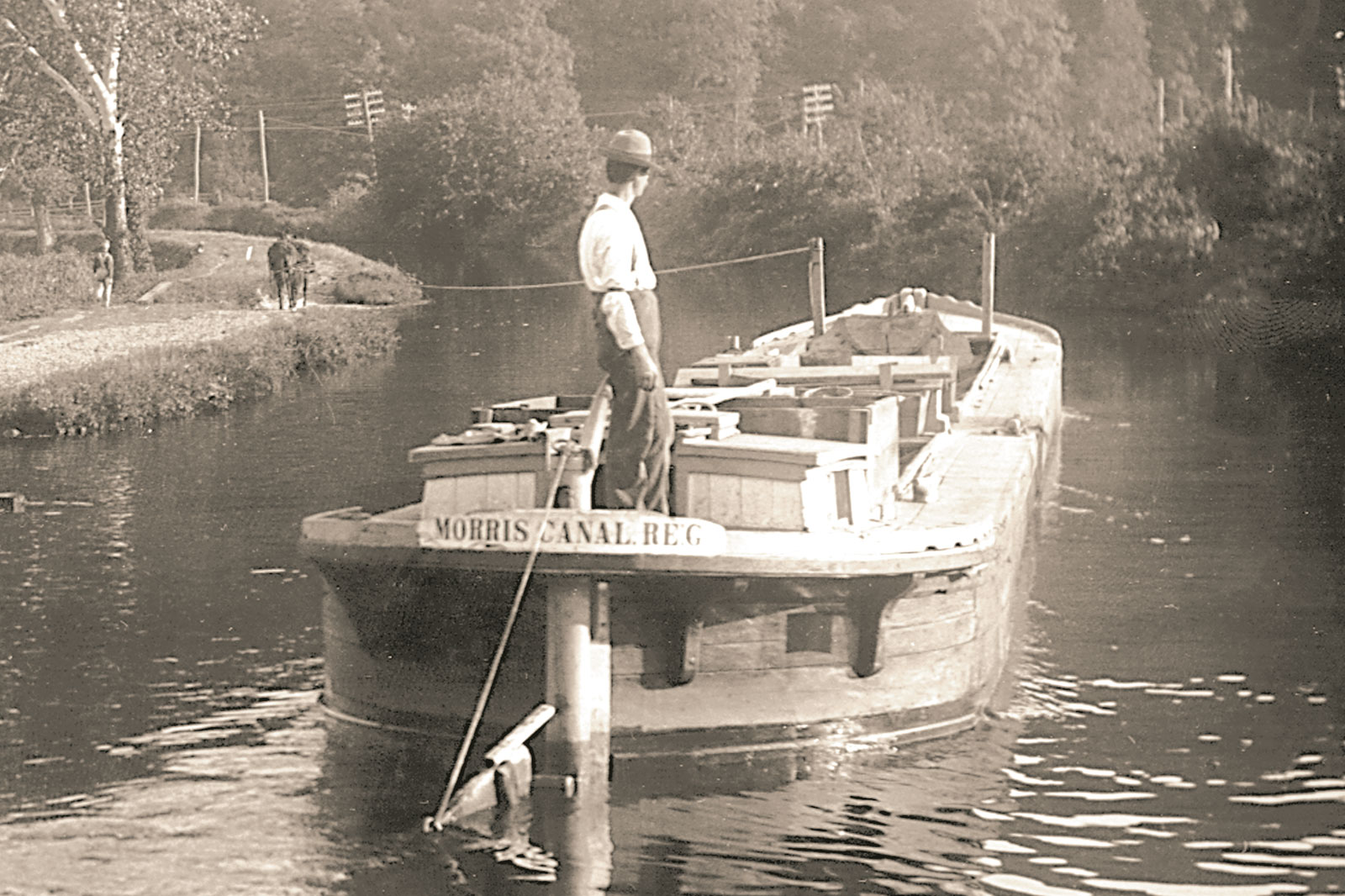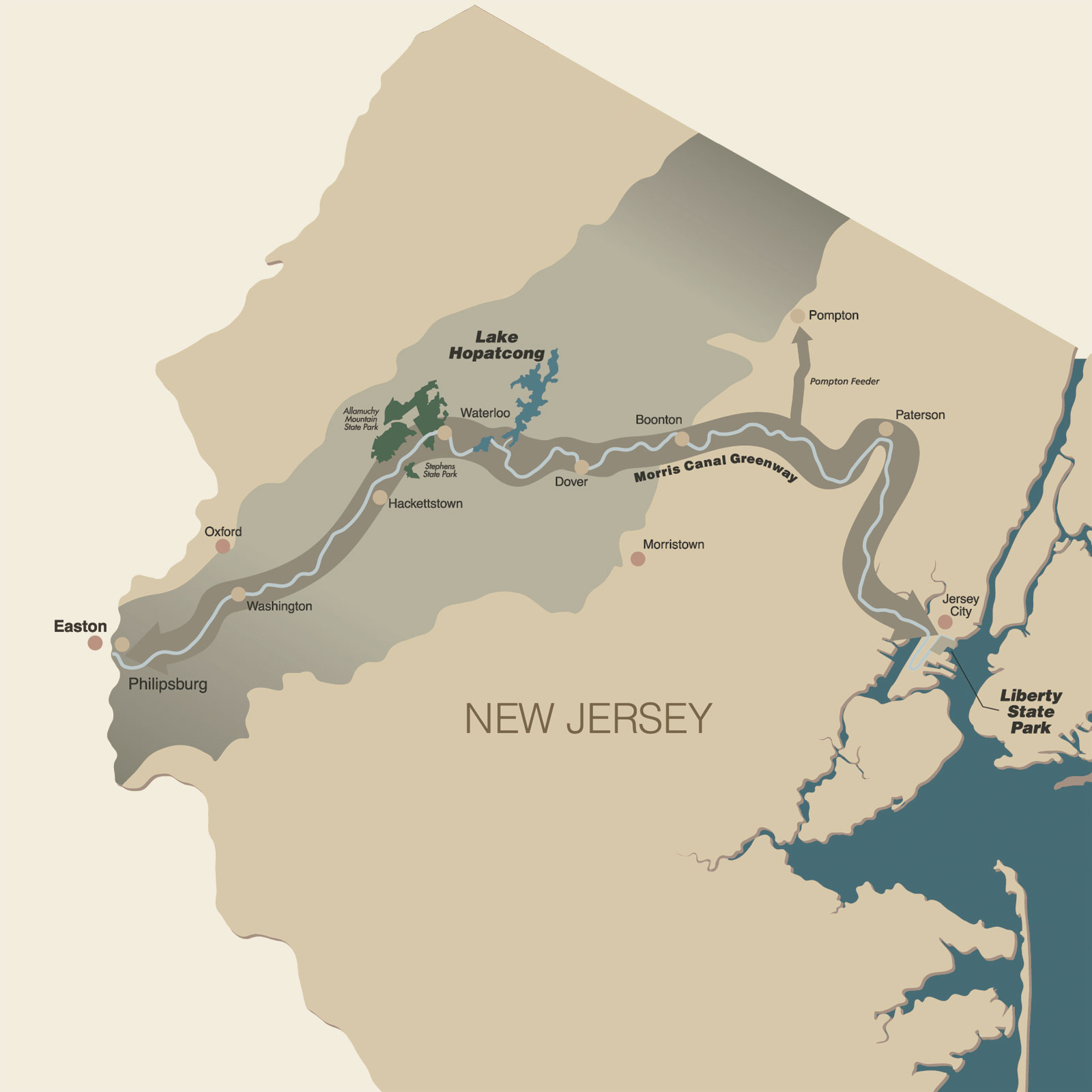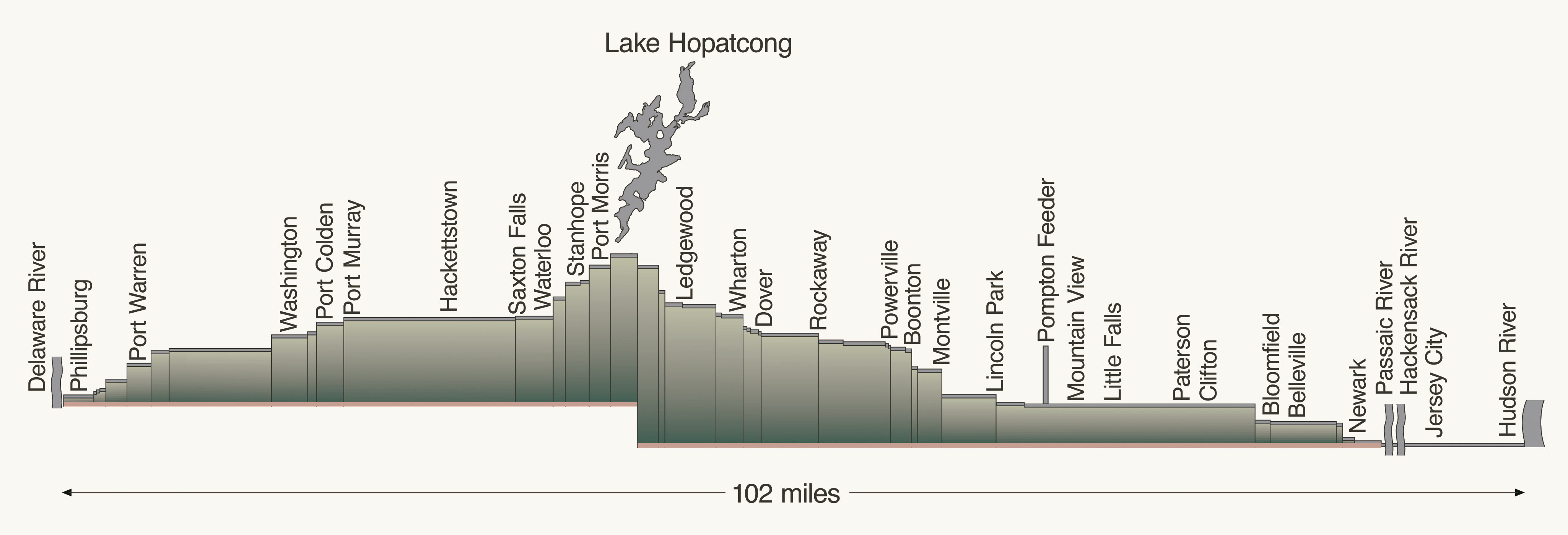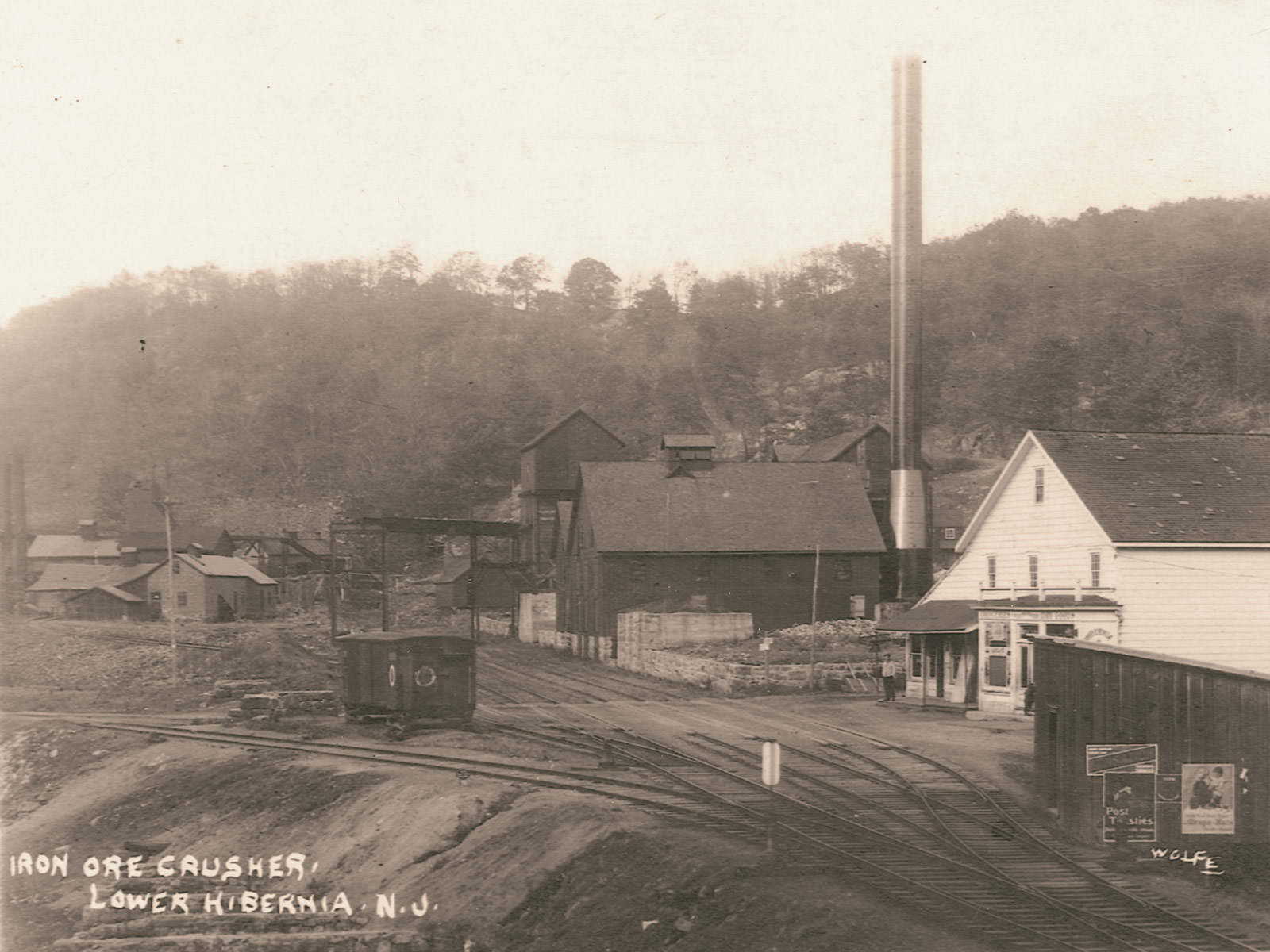Explore the Morris Canal
In 1824 the Morris Canal & Banking Company (MC&BC) was chartered to build a canal that would carry coal, mined in Pennsylvania, to developing markets along the eastern seaboard. The canal would pass through the heart of New Jersey’s iron district and provide the long-needed transportation system that would create new commercial activity and enable rustic settlements like Dover and Rockaway to grow into thriving industrial towns. The canal opened for business in 1831 and then, in 1836, was extended from Newark to New York Harbor at Jersey City.
When completed, the canal extended 102 miles across the rugged highlands of New Jersey, from Phillipsburg on the Delaware River, uphill to its summit level near Lake Hopatcong, and then down to Jersey City. To accomplish this, a system of 23 lift locks and 23 inclined planes were built to overcome the impressive elevation change of 1,674 feet. The canal’s famous water-powered inclined planes were an engineering marvel that enabled canal boats to be raised or lowered up to 100 feet at a time.
Mule-drawn canal boats transported up to 70 tons of cargo and took five days to cross the state. In the heyday of the canal, hundreds of boats carried everything from coal and iron ore to agricultural products. As New Jersey’s first industrial transportation system, the canal promoted commerce and shaped the economic development of the northern part of the state.
By the early 1900s the canal had become obsolete. However, it took until 1924 to adopt a plan to close and dismantle the canal. The ownership of the canal’s vast water resources, including Lake Hopatcong, Lake Musconetcong, and Greenwood Lake, passed to the state of New Jersey. Today, the Morris Canal Greenway, a partnership between local communities and the Canal Society of New Jersey, seeks to preserve the surviving historic remains of the canal, interpret canal sites, and offer recreational opportunities to the public.

Mule-drawn Morris Canal section boat heading west toward Dover in the early 1900s.

The Morris Canal connected with major industrial towns and cities in its day including Phillipsburg, Dover, Paterson and Jersey City.
GENERAL INFORMATION
| Length of main canal | |
|---|---|
|
Phillipsburg to Jersey City
| 102.15 miles |
| Length of Pompton Feeder | |
|
Feeder Lock to Mt. View (Mead’s Basin)
| 4.26 miles |
|
River Towpath, Feeder Lock to Pompton
| 1.75 miles |
| Elevation changes | |
|
Mean tide at Jersey City to summit near Lake Hopatcong
| 914 feet |
|
Summit to low water at Phillipsburg
| 760 feet |
|
Total change in elevation
| 1,674 feet |
| Costs | |
|
Original
| $2,104,413 |
|
Enlargement
| $1,700,000 |
| Number of inclined planes | |
|
Phillipsburg to Jersey City
| 23 |
| Number of locks | |
|
Lift locks
| 23 |
|
Guard locks
| 11 |
| Canal dimensions | |
|
Original canal
| Surface, 32 feet wide; bottom, 20 feet wide; depth, 4 feet |
|
Enlarged canal
| Surface, 40 feet wide; bottom, 25 feet wide; depth, 5 feet |
| One-way trip | |
|
Phillipsburg to Jersey City
| 5 days |
| Motive power | |
|
Number of mule teams
| 2 |

PLANES, LOCKS AND BOATS
| Inclined planes |
|---|
|
Inclined planes used water power to raise or lower canal boats as much as 100 feet at a time. Water from the upper canal level was used to create the motive power to raise and lower the boats. The water then flowed back in to the next lower level and was used over and over farther down the canal. The original inclined planes, built in the 1820s, used a counter balance system powered by an overshot water wheel. Although these planes worked, they were not powerful enough to be economically successful. When canal engineer William Talcott redesigned the planes in the 1850s, he used more powerful cast-iron reaction turbines. The new planes could raise and lower boats carrying 70 tons of cargo. |
|
| Locks |
|
Lock dimensions: |
|
| Boats |
|
Capacities:
|
|
Dimensions of 1860 boats:
|

WATER
|
Inclined planes used water power to raise or lower canal boats as much as 100 feet at a time. Water from the upper canal level was used to create the motive power to raise and lower the boats. The water then flowed back in to the next lower level and was used over and over farther down the canal. The original inclined planes, built in the 1820s, used a counter balance system powered by an overshot water wheel. Although these planes worked, they were not powerful enough to be economically successful. When canal engineer William Talcott redesigned the planes in the 1850s, he used more powerful cast-iron reaction turbines. The new planes could raise and lower boats carrying 70 tons of cargo. |
| Canal Reservoirs |
|---|
|
| Aqueducts |
|
| Long Levels |
|

COAL AND IRON
| Tonnage Shipped on the Canal |
|---|
| Year | Total | Coal | Iron Ore | Other Cargos | Net Income |
| 1845 | 58,259 | 12,567 | 5,802 | 39,890 | $18,997 |
| 1850 | 239,682 | 98,100 | 60,055 | 81,527 | $94,224 |
| 1855 | 533,204 | 290,730 | 113,294 | 149,180 | $272,125 |
| 1860 | 707,631 | 404,464 | 186,064 | 117,103 | $350,710 |
| 1866 | 889,220 | 459,175 | 290,165 | 139,880 | $616,350 |
| 1871 | 629,044 | 329,584 | 185,482 | 113,987 | $283,725 |
| 1875 | 451,045 | 250,047 | 99,607 | 101,390 | $270,216 |
| 1880 | 503,486 | 427,606 | 44,897 | 30,987 | $215,667 |
| 1885 | 364,554 | 301,654 | 21,803 | 41,095 | $101,487 |
| 1890 | 394,432 | 297,417 | 54,889 | 42,125 | $120,283 |
| 1895 | 270,778 | 259,778 | 0 | 11,153 | $208,557 |
| 1900 | 125,829 | 119,479 | 0 | 6,350 | $111,072 |
| 1902 | 27,392 | 20,411 | 0 | 6,981 | $52,076 |
| The peak year for tonnage and profits was 1866. |
| Iron Mine Railroads |
|---|
| Numerous tramways and railroads were built to bring ore from mines to the docks on the canal. Most eventually became through railroads. |
|

The Hibernia Mine Railroad shipped iron ore from the Hibernia mines to the Morris Canal.
IMPORTANT DATES
| Nov 15, 1822 | Act to investigate the feasibility of the canal passed |
| Dec 31, 1824 | Morris Canal & Banking Company chartered by the State of New Jersey |
| Jul 12, 1825 | Construction starts near the present town of Ledgewood |
| Nov 4, 1831 | First trip from Newark to Phillipsburg |
| 1832 | First full boating season |
| 1836 | Jersey City extension completed – 11.75 miles |
| 1844 | Company is reorganized |
| 1849 | Banking privileges eliminated |
| 1841 & 1845 | Canal enlargements |
| 1847 – 1860 | Inclined planes rebuilt to accommodate boats with 70-ton cargos |
| 1856 – 1870 | DL&W Railroad transports coal from northern fields to the canal docks at Washington |
| 1871 | Canal leased by the Lehigh Valley Railroad for 999 years (in perpetuity) |
| Nov 29, 1922 | State of New Jersey takes over the canal |
| Spring, 1924 | Canal drained |
| Dec 31, 1974 | MC&BC charter was due to expire in 1974. However, the company still exists as part of the State of New Jersey DEP |
Become A Member
The annual membership contribution is $25.00 per individual or family. Payment may be made by credit card or check.

